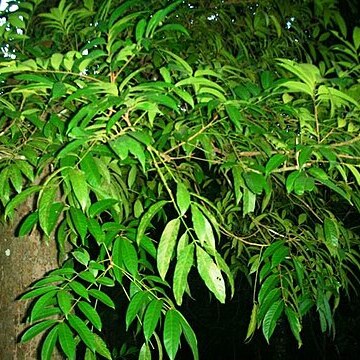Trees to 18 m tall. Leaves alternate; petiole and rachis ca. 35 cm; petiole glabrous, abaxially rounded, adaxially with a shallow groove; leaflets 11, opposite; petiolules 1-1.5 cm, thick, adaxially sulcate and stellately lepidote; leaflet blades oblong-elliptic, both surfaces ± glabrous, secondary veins 14-16 on each side of midvein, abaxially conspicuously prominent, and adaxially depressed, reticulate veins abaxially subprominent, base truncate to rounded, margin reflexed, apex acuminate. Thyrses axillary, 20-25 cm, stellately lepidote, branches thick and often pendulous. Flower buds ovoid, ca. 6 mm. Pedicel 2-4 mm, apex nodiferous. Calyx 3-lobed; lobes broadly triangular, outside stellately lepidote. Petals 3, ovate, 5-6 mm, outside densely stellately lepidote, inside concave and glabrous. Staminal tube urceolate, ca. 3 mm, glabrous, apical margin 10-lobed; anthers 10, linear to oblong, included. Ovary ovoid, 3-locular, densely covered with yellowish pubescence; stigma triquetrous to conical, base sulcate, apex 3-dentate. Fruit dehiscent, obovoid to pyriform, 3-locular, with 1 seed per locule, pubescent and sparsely stellately lepidote; stipe to 4 mm in diam. Fl. Sep-Nov, fr. Oct.
Tree to 40 m tall, with large plank buttresses; bark greyish white or brown, flaking in large squarish scales; latex white. Indumentum of reddish brown or pale brown stellate hairs or scales, densely covering twigs, petioles, rachis and petiolules, inflorescences and infructescences, calyces, outside of petals and fruits, with few to many on lower leaflet surface. Leaves 50–135 cm long. Leaflets (3–) 9–21, 8–40 cm long, 3–17 cm wide, coriaceous; veins 9–19 pairs; secondary veins subprominent on lower surface. Inflorescence to 40 cm long. Flowers 2–7 mm long, 2–6 mm wide. Petals 3, pinkish yellow. Staminal tube cup-shaped, c. 3 mm long and 2.5 mm wide; anthers 6, protruding beyond aperture. Infructescence 9–13 cm long. Fruit dehiscent, subglobose or obovoid, 6–9 cm long, 5.5–8 cm wide; pericarp to 1 cm thick with white latex. Locules 3, each with 0 or 1 seed. Seeds 5–6 mm long, with a complete red aril.
A tree that grows 25-30 m tall. It has buttresses. The twigs have dense brown scales. The leaves are compound. They are 20-70 cm long. There are 11-21 pairs of leaflets. The tertiary veins are prominent. The leaflets have few scales underneath except on the midrib. The leaflets are 8-40 cm long by 3-17 cm wide. The flowers occur in a group. The flowers have 3 white petals. They are 2-7 mm long. The fruit is a capsule. It is yellowish-brown and 6-8 cm long by 5.5-8 cm wide. It is densely covered with hairs. There are 1-3 brown seeds.


